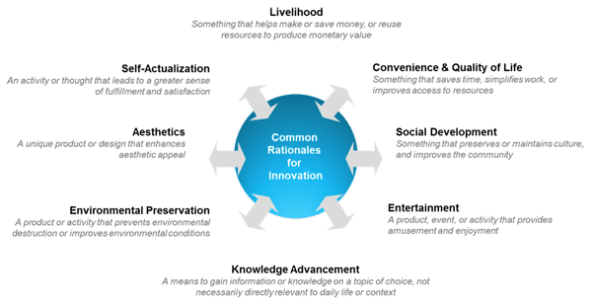With a radiant smile, a young metalworker in Nairobi told us that the fact that we were talking to him, asking him about his perspectives, was innovative. “Cross-cultural communication is taken for granted. But people of different races never talk to me!” he exclaimed.
This young man was one of 270 youth between the ages of 18 and 26 who participated in our recent study, “The Global Jugaad Commons” (GJC), which we conducted in 2011 to better understand how youth across four countries—Kenya, Tanzania, India, and Nicaragua—perceive “innovation.” The project also aimed to celebrate grassroots entrepreneurs and, most importantly, to encourage the cross-pollination of concepts and ideas and begin a dialogue around practical and scalable strategies to engage youth in self-determined development. (Jugaad, a colloquial Hindi word, captures the spirit of resource-constrained innovation.)
Several developing regions of the world are experiencing a burgeoning youth population, but youth from these resource-constrained environments often face skyrocketing unemployment rates and a litany of daily struggles, and often lack access to the opportunities they need to realize their full potential. Despite this, we believe they represent a tremendous resource for growth, and may hold the key to meeting the twin goals of economic development and poverty alleviation, since they’re exposed to entrepreneurial activities from very early ages. The narratives we captured spoke to the complex flavors of resource-constrained innovations, and shed light on the dynamic interdependence between innovation, culture, and context.
Three prominent themes emerged during our study. We share them here because, as the young metalworker noted, the idea of learning more about the factors that drive innovation seemed, to him, innovative in and of itself. If more funders, innovators, and entrepreneurs pursue studies like ours to understand youth perspectives, they may be able to better adapt innovative solutions to communal and cultural contexts, and formulate effective programs and strategies to facilitate and sustain organic growth in these communities.
1. Different rationales compel similar innovations.
Are you enjoying this article? Read more like this, plus SSIR's full archive of content, when you subscribe.
We were in Tanzania when we first heard people cite “indigenous medicine” as an innovation. Injoro was a medicine that cured stomachaches; ookokai relieved muscle pain. Ginger was administered to women going into labor to induce birthing by getting her to sneeze! As we talked with respondents who cited these innovations, we observed a deep sense of pride, stemming from communal identity.
Just across the border in Kenya, respondents also cited indigenous medicine as an innovation. But these interviewees, in stark contrast with study participants in Tanzania, frequently associated the innovativeness of indigenous medicine with economic benefits—the ability to save money by avoiding expensive “western” medicine. And in India, one respondent remarked that grassroots innovations in medicine largely happened because conventional health care was out of reach for the “common man.” In total, across 270 narratives, we identified eight sets of rationales explaining why certain products or ideas were perceived as innovative (see below).

Nearly 80 percent of respondents attributed innovativeness to the improvement of livelihoods (ability to help someone make or save money), or an increase in convenience and quality of life (ability to save time, simplify work, or access resources). But while participants in Tanzania linked innovativeness to abstract problem-solving or community identity, participants in Kenya and India distilled these rationales into nuanced explanations of how each innovation directly increased income or access to resources.
Understanding individual drivers for resource-constrained innovation can help entrepreneurs gain the quintessential buy-in from communities, but at a larger scale, systematic evaluations of innovation origins can help inform the design of targeted programs to engender self-determined development in individual communities.
2. Necessity is really the mother of invention.
When asked to talk about innovations that impressed them, study participants mentioned a wide range of products, systems, and ideas, ranging from cutting-edge technological solutions to indigenous-knowledge-based innovations. For example, respondents in Nairobi talked about BMW concept cars while respondents from rural Nyeri talked about jiko stoves that eliminated the adverse side effects of open-fire cooking. (The word cloud below illustrates the diversity we encountered.)
 (Image: Baskaran, S., Mehta, K., What is innovation anyway? Youth perspectives from resource-constrained environment. Technovation, 2016)
(Image: Baskaran, S., Mehta, K., What is innovation anyway? Youth perspectives from resource-constrained environment. Technovation, 2016)
As the above illustrates, while most people still associate innovation with technology, indigenous knowledge has also contributed to the development of practical solutions to pressing local problems associated with resource scarcities. So we took a step back to reflect on the innovations that stemmed from local knowledge and need. We asked ourselves: When was the last time any of us built a water filter instead of buying bottled water? Or repurposed non-recyclable waste into accessories? Respondents in Kenya and Tanzania were using homemade charcoal filters to make freshwater suitable for drinking; some even fashioned metal parts and discarded animal bones into beautiful jewelry, reducing landfill dumps in the process. These local solutions demonstrated to us that innovative spirit doesn’t have to be taught or nurtured through formal structures. They also caused us to wonder if more technologically advanced countries tend to take relatively inefficient approaches to solving problems, compared with the grassroots solutions generated in resource-constrained communities.
Adopting a ground-level lens to understand the interdependence between a community’s culture and innovation systems can help entrepreneurs tap into rich local knowledge to solve problems that gain acceptance within that community.
3. Socio-economic context affects how people perceive innovation.
Indian respondents said they didn’t consider mainstream technological products such as smartphones “real” innovations, since large corporations developed them for profit. They then distinguished these ”corporate” offerings from individual or community-driven innovations stemming from need.
In stark contrast, in rural Nicaragua, participants were reluctant to name an innovation they developed themselves, viewing their own ideas not as innovative, but rather as a “way of life.”
Meanwhile, in Kenya, a participant who fashioned jewelry from coconut shells said she considered her idea innovative because it was sold at Nakumatt (a high-end Kenyan supermarket). She mentioned that the growing middle-class in Kenya likes frequenting Nakumatt, because it demonstrates their ability to shop at larger retail chains instead of the local stores. Selling a product at Nakumatt, she added, improved her social status. Several Kenyan and Tanzanian respondents attributed the genesis of innovation to cultural and contextual factors surrounding the innovator, but emphasized that even individual innovations (such as the jewelry) collectively serve a large constituency, since they point to the availability of development opportunities within the community.
Interestingly, respondents from several locations (particularly in East Africa) talked about innovations stemming from cross-generational wisdom (for example, creating chicken coops from knitted grass, or treating common injuries with turmeric) with pride. However, when prompted for details, they often politely refused, telling us they preferred to protect what they considered confidential, family-oriented information out of a fear that “western entrepreneurs” would monetize their idea without due respect for the culture from which it emerged.
The number of very different narratives we heard speaks to the diversity of human experiences and the myriad factors that influence our collective destinies. For entrepreneurs and development agencies alike, understanding such differences in how people perceive an innovation is a critical first step toward developing practical solutions that address real needs in these communities. Such an understanding can also help local entrepreneurs commercialize their innovations, and will eventually further the quest for self-determined improvements and evolutions in lives, livelihoods, and cultural frameworks.
Cross-Pollinating Concepts Across Cultures
In this globally interconnected world, game-changing innovations are as likely to emerge from the backstreets of Bamako, the bazaars of Bombay, the barrios of Brasilia, or the basements of Boston as they are from major corporate research centers. But the learning capabilities of resource-constrained communities are often inextricably connected with the culture and context that defines their way of life.
Understanding those connections—learning more about the circumstances under which individuals innovate, and acknowledging how resource constraints can lead to inherently personal yet remarkable innovation systems—is important. These narratives provide a compelling argument in favor of developing an innovation ecosystem that embraces epistemological diversity. This diversity of knowledge is an important ingredient—and the only sustainable competitive advantage—in the development of vibrant innovation systems that foster sustainable and scalable approaches to address local and global challenges.
Support SSIR’s coverage of cross-sector solutions to global challenges.
Help us further the reach of innovative ideas. Donate today.
Read more stories by Shruthi Baskaran & Khanjan Mehta.

